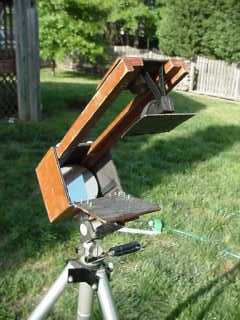
Last touched 2021 November 11
After experiencing observing with 10x50 binoculars from the aircraft carrier USS America (CV-66, now decommissioned) during a two week training cruise in 1981, I ordered a 4.25-inch f/4 RFT telescope kit from the original Coulter Optical for $34.95. I would be on the America for the next four years and would spend a lot of time at sea, away from city lights. The telescope kit caught up with me while the ship was at port of call, Perth, Australia, about half way through a seven month deployment to the Indian Ocean. I assembled the telescope, using the original Coulter sonotube and focuser. Mirror cell wood was scrounged from Israeli Apple crates borrowed from the mess hall trash pile. I got in trouble with my duty Petty Officer when I spray painted the inside of the cardboard tube in my workspace and filled the space with paint fumes. I successfully used this telescope, mounted on a photo-tripod for the rest of that cruise.
Shortly afterwards, I completed a 6-inch f/5 mirror and built a travel "boppian" two-strut telescope based on the designs of Thane Bopp, Richard Suiter and Tom Burns for use on the ship. However, when I decided to rework the 6-inch mirror just before another long deployment in 1983, putting the 6-inch out of action for several months, I also decided to rebuild the 4.25-inch RFT into the more compact "Boppian" two-strut design. This would allow me to carry more observing equipment to my observing station on the ship, as well as better allow me to carry the scope off the ship when I was limited to what I could hand carry on to a bobbing liberty boat.
This version of the telescope proved extremely successful, being used on two Indian Ocean and one North Sea deployments of the America. It went ashore in Kenya and supplied outstanding views from 5,000 ft altiude in the middle of the Tsavo West National Park (only about 2 degrees south of equator) in the shadow of Mount Kilimanjaro. It supplied my all time favorite view of the reflection nebulae in the Pleiades one very clear night in the Eastern Mediterranean Sea. I have taken it on countless trips to and fro... it's been displayed and normally ignored at Astrofest, Stellafane, Winter Star Party, Texas Star Party and others. It's sailed, ridden in cars, trucks and flown. It's been strapped to the backs of larger scopes. I've wrapped it in t-shirts, stuffed it into the middle of large suitcases and checked it for air travel. About the only thing I haven't done is drag it behind the car on a chain. I'm proud to say this scope is one of several that inspired Ron Ravneburg and his well known Alice telescope.
Mounted on a small tripod, sideways so the focuser is on the side and pointed at a young moon at 24x, this scope is always a hit at public star parties with small kids who don't need to climb a ladder or be held by their parents in order to take a look.
I cut the wood at the wood shop at the Naval Station in Norfolk, Virgina, but assembled the parts on board the ship. Only a table saw was used, but you could easily build this scope using a hand held saber saw. In haste of construction before leaving for the cruise, only the inside of the scope was painted black for the first seven or so months. It was finally stained in Columbus, Ohio, in 1984 while I was on leave because painting and staining was very difficult in the enclosed spaces on the ship.
The mirror box is made from 1/4-inch "AC" plywood. If I were to build it today, I'd likely use Luan plywood, sin>e it doesn't split as easy and is cheaper. The struts are 3/8-inch AC plywood cut from scrap. Both the box and struts are glued and nailed. T-nuts are used to support 3/4-inch long 1/4-20 TPI thumb screws. The focus board is also 1/4-inch AC ply. The focuser is the original Coulter push-pull focuser filed flat. About every other year, I find one of these focusers at star party flea market for a buck or so. Always a good deal for small scopes. The spider vanes are made from hack saw blades. I don't recommend this approach, as hack saw blades are very brittle and difficult to blend to sharp angles. Use sheet metal from a local hardware or hobbie store. The mirror cell is a piece solid wood (Israeli apple crate wood!) saved from the original scope. There are three pull bolts counter sunk in the cell. Three springs and wing nuts do the rest. The mirrors are glued in place using Aquarium cement. The primary mirror is further held in place by three paper clips (see image below) as an added safety measure. Secondary collimiation is achived by bending the hack saw blades or slideing the pressure fit secondary mirror mount on the hack saw blades. ep> I have always referred to this telescope as "Pringles." The short story is that while a group of Columbus (Ohio) Astronomical Society members were building 4.25-inch f/4 RFT's in an ATM class during the early 1980's, someone commented the telescopes looked like cans of Pringle potato chips, especially when the tubes were painted red. The name soon stuck to any 4 and a quarter F four RFT.
In late 2001, I discovered the original tube in the attic. After some thought, I remounted the optics in the original tube and built a very simple, but very useful mount to allow me to "hang" Pringles on the back of TJ, the 20-inch dobsonian. This position is ideal, in my opinion since it allows Pringles to be used a finder for the large telescope or provide an alternate view of large, extended objects. TJ is large enough the extra weight of Pringles doesn't impact the balance of the telescope. I keep a Vernonscope 24mm Brandon, the same eyepiece I used while on the USS America in the original Coulter focuser full time. At some point, I started to use a "Pouce" cat treat can, first to protect the eyepiece, but discovered it makes a perfect dew protector for the eyepiece rather than a complex and breakable eletric dew heater. You just lift the Pouce can off, take a look, point the telescope, etc, and replace the can.
About 2019, I did a little touch up; I cleaned the optics, tighten screws, etc after using Pringles on a tripod for an event.
In 2021, the secondary mirror holder failed. This holder, which dated back to 1983, was nothing more than a 3/4-inch piece of plywood glued to the back of the secondary mirror. I then carefully cut two slots for the hacksaw spider vanes to slide into. This worked very well. When I returned the optics to the original tube in 2001, I cut a third slot for the single vane spider. Over years, the center slot became more and more loose and it was common to have to re-align the mirror at the start of every observing session. In 2021, the slot widened to the point, with the plywood failing, and the mirror would no longer stay on the hacksaw blade.
In the shop, I used a drill to bore out the pieces of plywood between the original two outer slots. I then cut a piece of model aircraft quality plywood that I had in a scrap pile from model railroading, that was close to the thickness of the removed pieces. With some care, I filed and sanded the new piece to securely fit, then glued it in place. After drying, I once again cut a single slot for the hacksaw blade in the new piece. Once convinced all was well, I painted it flat black. Much to my surprise, I realized the outer edge of the secondary was unpainted, even after 40 years! This is a common mistake, since the edge of the secondary was partly aluminized, reflective and facing the focuser. This would allow stray light to reflect from inside the tube up into the focuser and into the eyepiece, causing a loss of contrast.
Reassembled, the little scope did duty during a backyard star party in November of 2021. It helped me quickly point TJ so not to keep a group of waiting. Later, when a novice observer wanted to see the 7 sisters in the 20-inch, he was surprised Pringles had a better, more pleasing view with it's wide field of view. Below are some images of the scope as of May, 2001.

A basic front view of the scope, assembled and on a tripod. Ready to observe, dinged, dented, scraped and beat up. With a 3 degree field of view at low power, this telescope does not really need a finder scope - I just point along one of the two struts. A card board baffle is glued to the back of the spider/secondary mirror support to provide shielding from stray light.
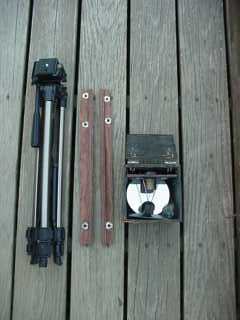
Here are the primary parts of telescope, disassembled. The mirror box lid is open to expose the focuser board in its stored position. You can also see the plastic bag that holds the six thumb screws used to assemble the scope. This bag was suppose to temporary until I built some other arrrangement to store the screws, But the bag worked so well, I've never changed it. Sometimes if I end up having to transport the scope in checked baggage, I'll remove the bag from the box during travel. I've also included a small travel size photo tripod.
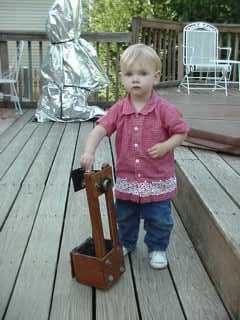
Here is my 20-month-old daughter, Maggie, getting her first lesson in newtonian collimation, a basic skill everyone need to survive in today's world. This is not a big telescope!
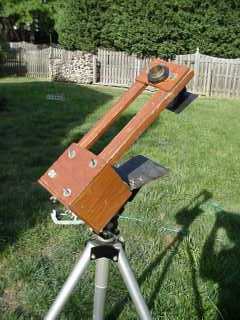
Mounted on tripod, a side view of the assembled scope. Good view of all six thumb screws (four on the box, two for the focus board), the push-pull focuser. Also, another view of the light baffle. Notice how the open lid of the mirror box rests on a tripod handle.
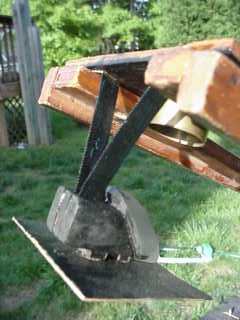
Close of up the spider/focus board. Hack saw blades for the spider. The secondary is glued to a small piece of wood that is press fit on the spider blades. The light baffle is glued to the back of the secondary support.
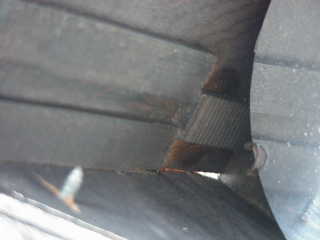
Detail inside the mirror box. This close up shows the small pieces of wood that hold the focus board for storage, as well as one paper clip restraint for the primary mirror. The primary mirror is glued in place, the paper clip is insurance.
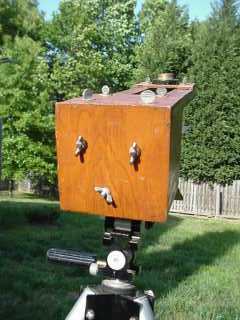
Here's the scope's back end. Just the three collimation screws here. Classic spring compression holding the mirror here. I've had to replace the springs a couple of times after they have compressed too low over time.
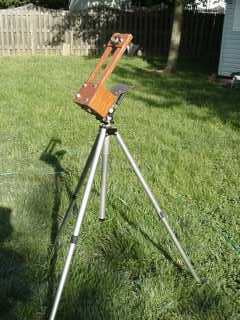
Here is the complete scope on a tripod, ready for dark skies.
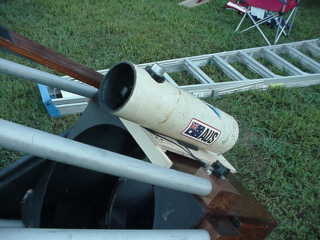
In August of 2001, I rediscovered the original tube in the attic. I remounted the optics in the original tube and built a simple mount to hang it off the back of TJ, my 20-inch f/6.4 dobsonian. Here is a view from the front.
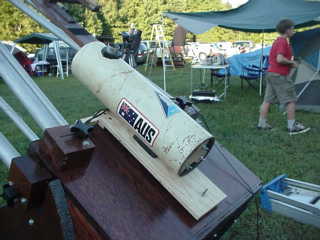
What is this? In the confines of the narrow walkway coming out of the starboard side of the bridge of the USS America (CV-66) - way up on the island structure, on the side away from the flight deck - I set up the Pringles telescope. I also set up my Nikon FM2 with a 35mm lense mounted on a very small tripod. I was unable to aim the camera because it was up against the bulkhead in an effort to get the Pringles telescope in the field of view. Using Ektachrome 200, I opened the shutter of the camera for about 5 minutes - about as long I could risk without someone coming out of the bridge and tripping over the tripods.
This happened in 1983, while the ship was enroute to the Gulf of Mexico. The ship was about 15 miles East of Fort Lauderdale, Florida.
At the bottom of the frame, you can see the horizon. The lights of Fort Lauderdale are just visible. While the shutter was open, I spent the time gazing at the shore with 10x50 bincs. I remember seeing the lights of airplanes and boats moving around. It was very quiet, and the signalmen on the deck above me were doing the same thing, only using the "Big Eyes" 20x120 bincs. I could hear them talking quietly. The skyglow of the city is the green blob. In front of the glow, you can see the tripod legs of the Pringles scope. The actual scope is lost in the dark of the sky around it. Also visible are the safety railings on the side of the walkway. These are steel tubes about 1.5-inches in diameter.
Just above the top railing, are the star trails of Castor and Pollux, the twin stars of Gemini. Their motion reprents the slow movement of the ship as it sails south at about 15 knots (17-18 mph). This is a bit more motion then normal, but nonetheless these are observable conditions from the ship. As long as the ship was not turning, normally, objects moved around in the wide field of Pringles, but rarely moved out of the field of view. Here, you can see a series of up and down movements - the ship rocking port to starboard - with an occasional larger movement - more likely caused by minor course corrections from the bridge.
I actually preferred to observe while the carrier was conducting flight operations. The reason for this was the advanced knowledge of the sea conditions. For the ship to fly planes, it had to be sailing into the wind. This minimized the rocking motions. It also meant the ship wasn't going to turn. The worse thing was to spend a few minutes hunting down a deep sky object or variable star, only to have the object zip out of the FOV as the ship started a turn! Sailing into the wind also meant the hot gases coming from the ship's stack were pushed backwards and away from my location. If the wind came from the starboard side, the gases passed over my head and ruined the seeing something horrible (5-10 arcsecond stars!).
The biggest downside observing during flight operations was the noise and vibration. Ear plugs and ear protectors were kept in my observing kit. As planes took off and landed, their jet engines were at full power, making a racket that wakes the dead. As a plane took off, the catapult shot shook the entire ship. The vibration lasted several seconds before dieing away. A landing plane also created vibration, but not so bad. Once the flight operations routine was understood, you knew exactly when these events took place, so I'd just relax my eyes and glance up to check the sky conditions until the vibrations died away.
Two quick notes about observing from a ship at sea: It was often partly cloudly. But if the ship was steaming, the clouds move past very quickly. If a cloud interrupted an observation, it was usually better to wait five minutes for the cloud to pass then to move on to another object. If we were away from land, the clouds were normally not directly visible. You could only "see" them because you could not see the stars behind them. This is because there was no light pollution to reflect from the cloud. On rare occasion, I've ran into other amateurs who have described this effect. When someone describes these "dark" clouds, I know they've been under truely dark skies.
03:30AM, July 3, 1982. 20 degrees north, in the Carribean Sea. I made estimates of three variable stars and this drawing of M-31. My notes say the Moon was just setting, the ship was heading north, 10-15 knots with 20 mph winds, seas calm. Partly cloudy, very nice and peacefull. (notice the dark lanes in the front of the galaxy)
May 11, 1982, 34 degrees north, Altantic Ocean. I looked at a number of Messier objects and drew M-83. Recorded "Slight detail, large, easy." I was observing from the Starboard side of the ship, 09 level just behind the bridge. The ship was heading 310 degrees, turned a couple of times, with some flight operations. Rough seas and very windy.
June 17, 1982. 18 degrees north, near Puerto Rico. Omega Cent. at 17x. "Not as good as seen from the Red Sea (using 25x120 Ship's Bincs on the Destroyer USS Preble in 1981). Slight resolution towards edges".
I also looked at NGC 5128 and made estimates of four variable stars. My notes say the sky was bright, partly cloudy, spent time waiting for clouds then observing, seas were very calm, small white caps, flight operations.
24 Nov 83. 25 degrees north, near Puerto Rico. 85 degrees F. Calm, partly cloudy, 20 knot wind from NE. WOW! Great night! Flight ops, NGC-134 was very hard to see, only a light spot against the black sky. Should be close to the limit for a 4.25-inch! (11.4 mag) Seas where mild, with 3-5 foot waves, gusting winds up to 20-30 knots. Ship vibrations was not that bad, only then planes tookoff or landed. NGC 55: Long, narrow, bright nuc that extended the entire narrow width. Very nice! Better than 10-inch in Virginia! 17x, 24mm Brandon.
24 Nov 83. 25 degrees north, near Puerto Rico. 85 degrees F. Calm, partly cloudy, 20 knot wind from NE. WOW! Great night! Flight ops, NGC-134 was very hard to see, only a light spot against the black sky. Should be close to the limit for a 4.25-inch! (11.4 mag) Seas where mild, with 3-5 foot waves, gusting winds up to 20-30 knots. Ship vibrations was not that bad, only then planes tookoff or landed. NGC 300: Big, nuc easy, arms seen only with much trouble, very nice, again better then 10-inch. Stars in nuc. 17x, 24mm Brandon.
26 Nov 83. Puerto Rico. 80 degrees F, 25 knots southly wind. An ok night. Flight ops. Calm water, partly cloudy. A couple of meteors. NGC 253: Large, bright, bright center with one dark lane. 50x 24mm Brandon plus 2.4x Dakin barlow.
27 Nov 83. Puerto Rico, about 20 degrees north. 80 degrees F, calm. Another great night. M-45 was the best I've ever seen it so clear and the neb. so easy. A total of 14 galaxies with the 4.25-inch. Map of Fornax is below (in my notes, a copy of the Astrocard). Flight ops, partly cloudy, calm 0 degrees rocking, nice. (Note, July 12, 2001: this is my all time favorite observation of M-45. I've never seen it better in all these years and dozens of telescopes later!)
10 Dec 83. 30 degrees north, off Jacksonville, Fl. 60 degrees F, rough seas. Very windy, rocking 3-5 degrees, ship turned no less than six times in one hour! Flight ops. Limiting Mag and transparency were good, about 11.5 mag. 2237 was highlight for the night. Once again, jet fumes burned eyes. NGC 2237: Faint, but easy. Much like M-45, central dark area easy. Very nice, two stars! 17x, 24mm Brandon.
28 Feb 84. 20 degrees north, near Puerto Rico. 85 degrees F. Calm. A good night! Ship heading west in very calm sea and a northernly 10-20 knot wind. Dark skies, almost no clouds. Ship did high speed run during the first 20 minutes of observing. Very quiet after run, almost pleasent! M-106: Super. Bright nuc, look like a mini-M-31. Quick but even drop in brightening to edge.
Comments To:bbunge@ladyandtramp.com
Back to Bob's Homepage.
Observations
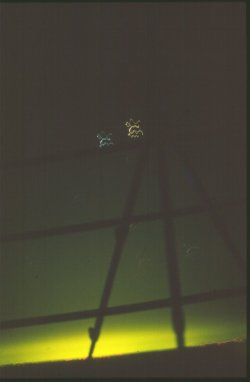
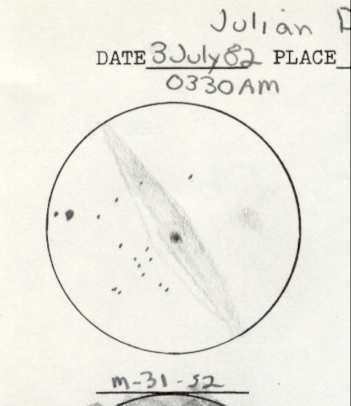
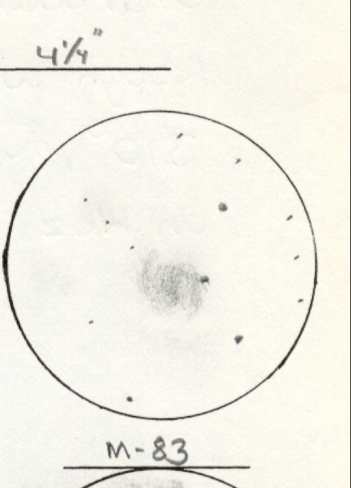
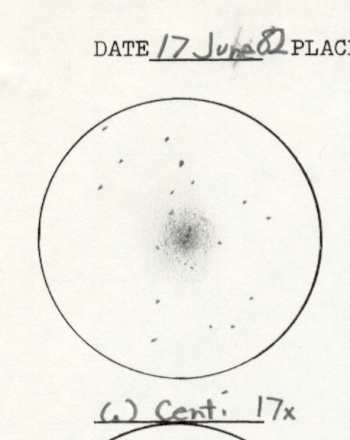
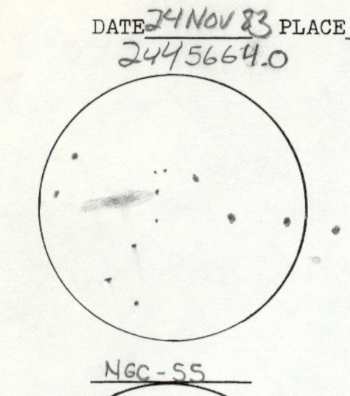
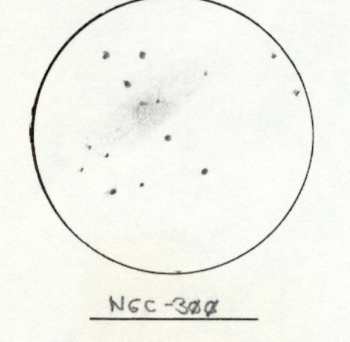
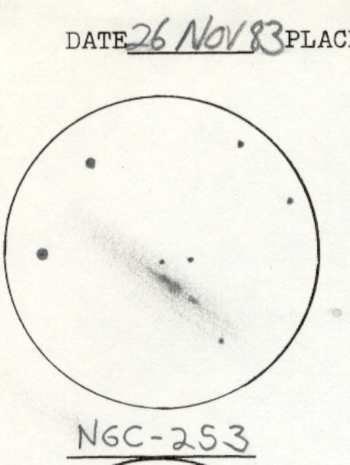
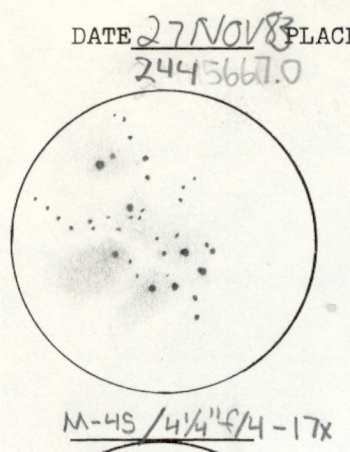
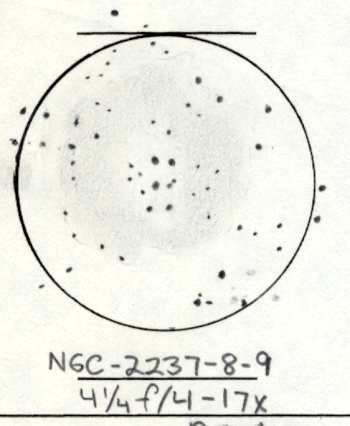
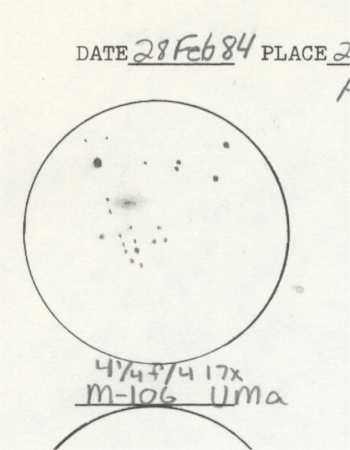
All photos, images and html on this site are copyright, Robert Bunge, 2001. All rights reserved.